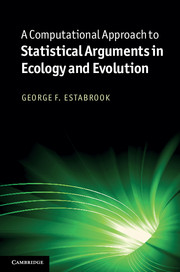Book contents
- Frontmatter
- Contents
- Acknowledgments
- 1 Introduction
- 2 Programming and statistical concepts
- 3 Choosing a test statistic
- 4 Random variables and distributions
- 5 More programming and statistical concepts
- 6 Parametric distributions
- 7 Linear model
- 8 Fitting distributions
- 9 Dependencies
- 10 How to get away with peeking at data
- 11 Contingency
- References
- Index
6 - Parametric distributions
Published online by Cambridge University Press: 05 June 2012
- Frontmatter
- Contents
- Acknowledgments
- 1 Introduction
- 2 Programming and statistical concepts
- 3 Choosing a test statistic
- 4 Random variables and distributions
- 5 More programming and statistical concepts
- 6 Parametric distributions
- 7 Linear model
- 8 Fitting distributions
- 9 Dependencies
- 10 How to get away with peeking at data
- 11 Contingency
- References
- Index
Summary
Basic concepts
Parametric distributions are used extensively in classical statistics because mathematicians have manipulated their calculating formulas to devise test statistics whose predicted distributions are among the pre-calculated ones, some of which are listed in the backs of older statistics books. In addition, if a member of a parametric family adequately describes the variation in data of interest, these data can be used to estimate values for parameters; the name of the family together with values for its parameters make a useful summary description of that variation. Parametric distributions can also help define a hypothesized random process when you take a computational approach to statistical argument.
Binary distributions
Consider again a binary random variable b with possible values 1 and 0 and a distribution given by Pr(b = 1) = p. Specified in this way, the random variable, b, is chosen from a large class of random variables that differ with respect to the mechanisms that sample them, but always have only two possible values, 0 and 1. Although the random variables in the class to which b belongs may differ, their distributions will be the same if Pr(b = 1) is the same for both. We use the word, family, to refer to a collection of distributions that all have the same form, such as all the distributions for the random variable, b, but differ by the value of a number, such as p, which we call a parameter. Distributions that can be easily specified by designating the family to which they belong and specifying the value of a parameter (or sometimes the values of two or a few parameters), are called parametric distributions. Well-known families have names. The distribution of the random variable, b, belongs to a family named binary distributions.
- Type
- Chapter
- Information
- Publisher: Cambridge University PressPrint publication year: 2011



